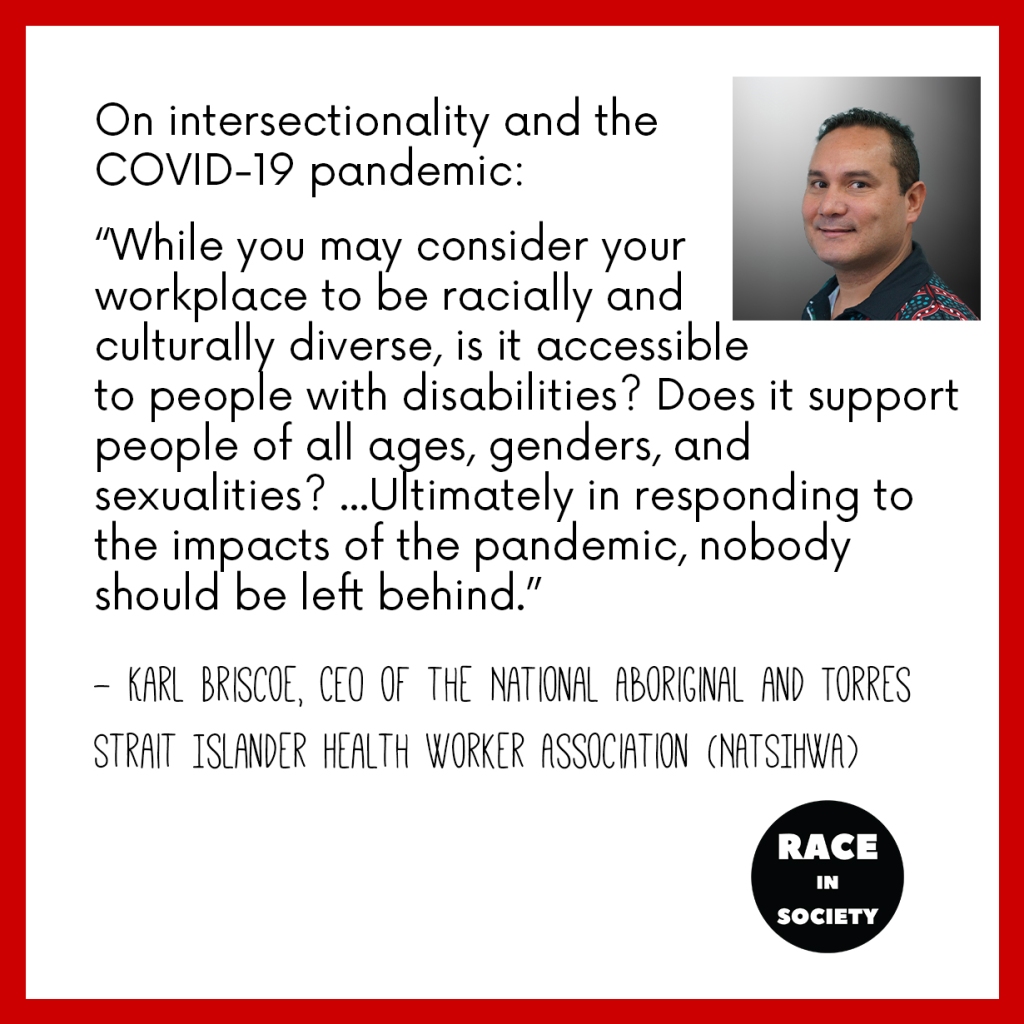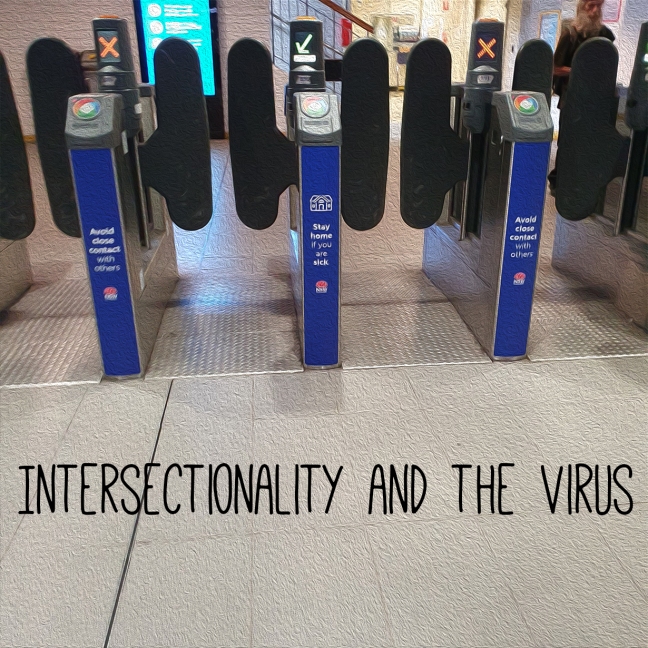In Episode 5 of our Race in Society series, Associate Professor Alana Lentin and I lead a panel exploring the impact of race, gender, and socioeconomics on COVID-19, through a lens of intersectionality. Writing in 1989, Professor Kimberle Crenshaw showed that industrial law in the USA treated racial and sexual discrimination as distinct experiences. She showed that Black women experience both racism and sexism simultaneously, and so the impact of each is compounded. Professor Patricia Hill Collins and other theorists have also shown that, without using this term specifically, people in the Global South have used intersectionality as an analytical tool, since at least the 1800s, to grapple with the complexity of discrimination. In Australia, we look to the works of Professor Aileen Moreton-Robinson, such as her book, “Talkin’ Up to the White Woman,” which examines how white feminist research has established authority by mobilising whiteness and enacting power over Aboriginal women. Intersectionality is not an identity, but rather a way to understand power relations in society, as well as social inequality, by looking at the interconnections of social division, including race, gender, disability, sexuality, and class.
In the video below, we speak with Karl Briscoe, the Chief Executive Officer of the National Aboriginal and Torres Strait Islander, Health Worker Association (NATSIHWA). His organisation has been proactive in producing resources throughout the pandemic, from advice to Black Lives Matter protesters, as well as the Aboriginal and Torres Strait Islander Health Professionals Resource Toolkit. He discusses how intersections of race and health impact the work by Aboriginal healthcare workers. We then speak with Professor Karen Farquharson, who has studied race in Australia, South Africa, and the United States. She explores how ideas of whiteness are used to dehumanise Black people, and how this has led to disparate health outcomes during the pandemic. Finally, Dr Nilmini Fernando is a Postdoctoral Research Fellow at Griffith University and a scholar of Black and post-colonial feminisms. She discusses a gap in the domestic and family violence sector, with respect to how violence is measured and categorised. Specifically, its inadequate attention to intersectionality. She notes that, by focusing on colonial definitions of violence, women of colour are inadequately protected when trying to rebuild their lives during social isolation.
Karl Briscoe on health
Karl Briscoe is a Kuku Yalanji man from the Mossman Daintree area in far North Queensland, Australia. Karl discussed how Aboriginal and Torres Strait Islander people have managed to mitigate the risks associated with COVID-19. NATSIHWA is one of four national organisations working to ensure Australia’s healthcare system meets the needs of Aboriginal and Torres Strait Islander people. His organisation takes a holistic approach to addressing social disadvantage, systemic racism, and trauma on the health and wellbeing of Aboriginal and Torres Strait Islander people. He discussed how one quarter of Aboriginal and Torres Strait Islander populations live in remote areas, making healthcare access difficult. Aboriginal and Torres Strait Islander communities are highly mobile, with people frequently travelling between communities over long distances, making them highly vulnerable to the spread of diseases. There is a high proportion of Aboriginal and Torres Strait Islander people who live in overcrowded homes, making self-isolation difficult.
NATSIHWA ensured COVID-19 communication was tailored to meet the needs of diverse cultures and communities. They partnered with government to develop culturally informed strategies, and they engaged leaders at local levels to coordinated action.
NATSIHWA co-produced a COVID-19 toolkit and delivered webinars specifically targeting Aboriginal and Torres Strait Islander health professionals, especially to promote self-care. They held yarning circles, and distributed regular COVID-19 updates.
Karl sees that key challenges in future will be ensuring equitable and timely access to a vaccine. (Note this was filmed in 2020. Vaccine access to Aboriginal and Torres Strait Islander people has since proved inadequate.)
Karen Farquharson on anti-blackness
Professor Karen Farquharson discusses how her work draws on Critical Race Theory, which emerged from critical legal studies. She describes how this theory proposes that social institutions (for example, the government, the education system, and race) are structured so that in white-dominated societies like Australia, white people will be in control of decision making and in control of most resources. For non-whites to access resources, whites must consent. In Critical Race Theory, anti-racism will only come about when there is interest conversion. That is, anti-racist action needs to be in the interests of the white majority to gain traction. Otherwise, white people resist change, and any kinds of attempts will be symbolic.
She then explains how norms of European whiteness are:
“The norms around who should be in decision making roles, where people should live, how people should be in public. And these were all racialised in such ways as to prioritise people classified as white and deprioritise people not classified as white. Norms of European whiteness are connected to anti-blackness, and anti-blackness is racism specifically against Black peoples. And that includes dehumanisation.”
– Professor Karen Farquharson
Karen shows how situating Black people as less than human allows the justification for discrimination. For example, non-Black people will refuse to be examined by Black medical students, and they don’t believe that Black people get into prestigious universities like Harvard University solely based on merit.

Karen discusses how Black people in the USA and UK are far more likely to die from COVID-19 than any other group. This is because of racism. Karen cites the book “Thick,” by American sociologist Professor Tressie McMillan Cottom, who experienced tragic consequences during her pregnancy trying to receive medical care, even though she is well educated. More broadly, Black people are more likely to experience chronic illness, they live in crowded conditions, they are less likely to have sick leave, and they experience discrimination when trying to get healthcare.
“So, if you need the money and you have to work, you don’t have as many choices, and you’re more likely to go to work sick and therefore more likely to spread COVID, but also more likely to catch COVID.”
– Professor Karen Farquharson
Karen notes we don’t have racial data for Australia, because we don’t really track race. In fact, she notes that, thanks to Aboriginal-controlled organisations like NATSIHWA, Aboriginal and Torres Strait Islander people have experienced much lower rates of infection than might have been otherwise. However, Karen notes that Asian-appearing people have been experiencing public racism since the advent of COVID.
Karen argues that intersectionality is a useful concept to highlight how different people will have different outcomes in terms of COVID. For example, analysing COVID-19 through an intersectional lens, enables us to consider:
- women who are working in aged care, who are often not white, might have a different experience than white men working at a university. They may be in insecure employment. They might have to work in multiple facilities rather than a single job. They likely can’t perform their work at home; and
- international students who are tied to workplace visas. They don’t have the option to avoid going to work, as they’re ineligible for government assistance, such as JobKeeper and JobSeeker
At the same time, Karen argues that intersectionality doesn’t provide answers. Instead, intersectionality theory points out questions that should be asked and illustrates issues that require change.
Nilmini Fernando on domestic and family violence
Dr Nilmini Fernando notes that the domestic and family violence sector is structured around colonialist ideas of gender, race and class, which in turn means there’s more focus on physical violence and less on state violence. For example, the established system pushes domestic violence survivors to leave the household where they’re experiencing violence, without providing adequate resources to counteract financial abuse. This forces women to liaise with dozens of different agencies just to survive, and exposes them to other institutional harm, including racial discrimination.
Nilmini then exemplifies how the domestic and family violence sector positions the criminal justice system as a solution to gender violence, even though policing powers have increased during COVID-19, and directed penalties onto people of colour. Nilmini notes that the criminal justice system doesn’t serve people of colour; it serves whiteness. Instead, the system victimises and targets people of colour, especially Aboriginal and Torres Strait Islander people who face high rates of deaths in custody.
Nilmini draws on the work of Professor Aileen Moreton-Robinson, who notes white feminist bureaucrats have corporatised the not-for-profit sector. White women lead how domestic and family violence is framed. White women also control how the system functions. In effect, the sector reproduces colonialism, and perpetuates whiteness. Nilmini sees value in drawing on Patricia Hill Collins‘ theorisation of intersectionality to understand how racial power is structured within organisations. Nilmini notes how feminists of colour are strongly focused on anti-capitalist critiques of violence. Women can’t leave violence situations without financial autonomy, and programs that simply focus on upskilling individuals also do little to change this material condition.
Nilmini uses intersectionality in her work as a form of literacy; that is, it provides concepts and language to inform practice and change.
Nilmini notes that white women are only invested in change that directly benefits them. They don’t see that racial power needs to be challenged, because (of course) the racial system gives them some power (over people of colour). The question that intersectionality throws up is: how do we challenge this position?

Intersectionality during COVID-19
We asked the panellists to reflect on how intersectionality illuminates issues during the pandemic.
Karl says that a holistic approach recognises that health and wellbeing of Aboriginal and Torres Strait Islander people doesn’t exist in isolation. The concept of intersectionality highlights that multiple forms of inequality impact health outcomes.

Karen argues that the term intersectionality turns people off. “I think they don’t understand it, and they don’t want to engage with it. And I’ve been using it for quite a few years now… people’s eyes glaze over… but I think people are very concerned about the differential effects of the pandemic on different types of people.” Karen notes that Victoria’s second COVID-19 lockdown, there was a characterisation of security guards as careless racial minorities who didn’t follow instructions properly, which is not the case. These workers were very concerned about transmission, but they were not given proper advice about COVID-19.
Nilmini agrees with Karen. White feminists have sought to neutralise discussions of intersectionality, selectively engaging with its theory, and mediating its use. For example, white women will limit women of colour’s contributions on panels about intersectionality. White women often invite women of colour into hostile conversations, where they are painted as angry women, or alternatively, to make the discussion safe for white women.
“It’s almost like it’s just become a buzzword. And I feel that it’s been undone, which is a critique that Sirma Bilge gives us where it’s been undone… it’s being a sort of adapted and inserted into whiteness.”
– Dr Nilmani Fernando
References
Bilge, S. (2019). Saving Intersectionality from Feminist Intersectionality Studies 1. Du Bois Review, 10(2), 405–424. https://doi.org/10.1017/S1742058X13000283
Carroll, L., Ward, M., & Gladstone, N. (2021, October 19). Four in 10 not double-jabbed: Indigenous vaccination rates lag. Sydney Morning Herald. https://www.smh.com.au/national/nsw/four-in-10-not-double-jabbed-indigenous-vaccination-rates-lag-20211019-p591bb.html
Crenshaw, K. (1989). Demarginalizing the Intersection of Race and Sex: A Black Feminist Critique of Antidiscrimination Doctrine, Feminist Theory and Antiracist Politics. University of Chicago Legal Forum, 1989(1). http://chicagounbound.uchicago.edu/uclfhttp://chicagounbound.uchicago.edu/uclf/vol1989/iss1/8
Crenshaw, K., Gotanda, N. T., Peller, G., & Thomas, K. (Eds.). (1996). Critical Race Theory. The New Press. https://thenewpress.com/books/critical-race-theory
Hill Collins, P. (2019). Intersectionality as Critical Social Theory. Duke University Press.
McMillan Cottom, T. (2019). Thick. The New Press. https://thenewpress.com/books/thick
Moreton-Robinson, A. (2000). Talkin’ Up to the White Woman : Indigenous Women and Feminism. University of Queensland Press. https://www.uqp.com.au/books/talkin-up-to-the-white-woman-indigenous-women-and-feminism-20th-anniversary-edition


